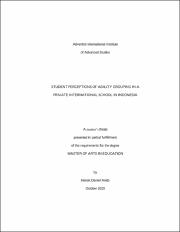| dc.description.abstract | This study investigated the perceptions of middle and high school students in a private international school in Indonesia toward ability grouping practiced in the school. The study aimed at measuring respondents’ overall perception of ability grouping; comparing perceptions across gender, ability groups, and grade levels; and exploring the perceived advantages and disadvantages of ability grouping. A total of 640 students from middle school (grades 7-9) and high school (grades 10-12) responded to the ability grouping survey questionnaire constructed by the researcher. The research instrument contained 10 items on a 5-point Likert scale and 2 open-ended questions.
Descriptive statistics revealed that the students had an overall neutral perception of ability grouping. The independent samples t-test resulted in no significant difference between male and female students’ perceptions. Similarly, the ANOVA test revealed no
significant difference between low, middle, and high ability students’ perceptions of ability grouping. However, there was a statistically significant difference in students’ perceptions when grouped according to grade levels. It was noted that grade 11 students significantly differed from grade 7 and 9 students. They leaned more towards disagreement with ability grouping. Moreover, although the respondents identified several advantages of ability grouping mainly for high ability students, an overwhelming majority of them perceived that ability grouping has more disadvantages, especially for low ability students.
Since ability grouping appears to be more disadvantageous to the low-ability students, it is recommended that the administrators design after-school enhancement programs and extracurricular activities especially targeting students in the low ability groups. Teachers also need to employ differentiated instruction and cater to the unique learning styles of students in the different ability groups. Besides, since it was found that the student population had an overall neutral perception of ability grouping, a further study that measures the perceptions of teachers, administrators, and parents would be helpful as a basis to continue, modify, or discontinue the practice. | en_US |

